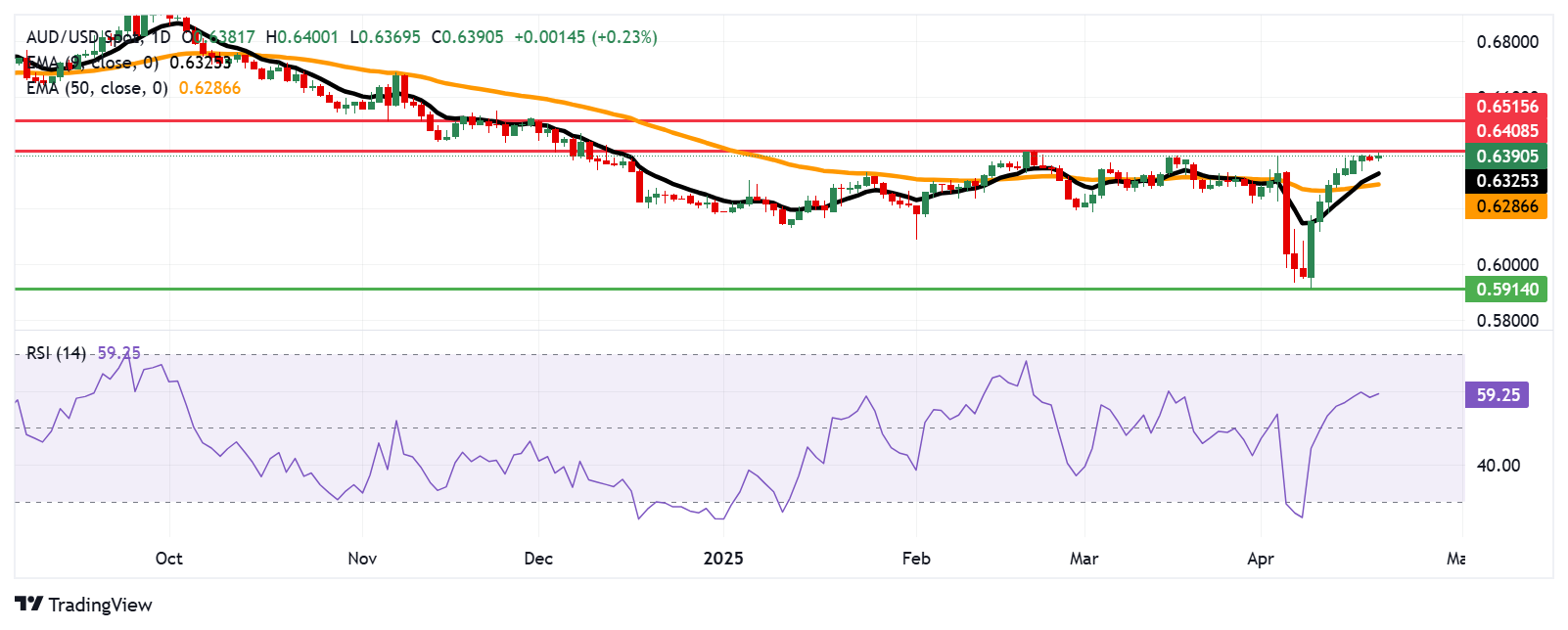-
The Australian Dollar held steady after the People’s Bank of China kept its one- and five-year Loan Prime Rates unchanged at 3.10% and 3.60%, respectively.
-
The AUD gained ground as the US Dollar weakened amid growing concerns over the economic fallout from newly announced US tariffs.
-
Trade tensions intensified following the White House’s decision to impose tariffs on Chinese vessels docking at American ports.
The Australian Dollar (AUD) regained ground against the US Dollar (USD) on Monday, recovering losses from the previous session. The AUD/USD pair remained resilient after the People’s Bank of China (PBoC) left its Loan Prime Rates unchanged, maintaining the one-year rate at 3.10% and the five-year rate at 3.60%.
The pair found support as the US Dollar softened due to growing concerns over the economic fallout from newly imposed US tariffs. Additional strength in the AUD came after US President Donald Trump announced exemptions for critical technology products—many of which are manufactured in China, Australia’s largest trading partner and a key destination for its commodity exports.
Despite the positive sentiment, trade tensions lingered as the White House levied new tariffs on Chinese ships docking at US ports, potentially disrupting global shipping routes. However, on Thursday, Trump revealed that China had made conciliatory moves and remarked, “I don't want to go higher on China tariffs. If China tariffs go higher, people won't buy.” He added that a trade agreement could be achieved within three to four weeks.
Australian Dollar strengthens as US Dollar weakens on falling 2-year Treasury yield
- The US Dollar Index (DXY), which measures the USD against a basket of six major currencies, declined over 0.50%, trading around 98.50—its lowest level since April 2022. The Greenback came under pressure as the yield on the 2-year US Treasury note fell more than 1%, settling at 3.75%.
- Federal Reserve (Fed) Chair Jerome Powell warned that the dual threat of a slowing economy and persistent inflation could complicate the Fed’s mandate and raise the risk of stagflation. Political tensions also surfaced, with reports suggesting President Trump’s dissatisfaction with Powell and possible discussions of his removal. While the markets showed limited reaction, White House economic adviser Kevin Hassett confirmed that such considerations were underway.
- From a macroeconomic perspective, US labor data showed mixed signals. The Department of Labor reported that Initial Jobless Claims dropped to 215,000 for the week ending April 12, beating expectations and down from a revised 224,000 in the prior week. However, Continuing Jobless Claims rose by 41,000 to 1.885 million for the week ending April 5.
- On the inflation front, the US Consumer Price Index (CPI) moderated to 2.4% year-over-year in March, down from 2.8% in February and below the 2.6% consensus. Core CPI, excluding food and energy, rose 2.8%, easing from 3.1% and missing the 3.0% forecast. On a monthly basis, headline CPI edged down 0.1%, while core CPI increased by 0.1%.
- In Australia, the unemployment rate ticked up to 4.1% in March, just below market expectations of 4.2%. Employment Change showed a gain of 32.2K jobs, missing the 40K forecast.
- The Westpac Leading Index’s six-month annualised growth rate, which signals likely economic momentum over the coming months, declined to 0.6% in March from 0.9% in February.
- Minutes from the Reserve Bank of Australia's (RBA) March 31–April 1 policy meeting reflected ongoing caution regarding the timing of the next rate move. While the Board viewed the May meeting as a potential juncture for reviewing policy settings, it emphasized that no decision had been made. The Board also highlighted both upside and downside risks to the domestic economic and inflation outlook.
- China’s GDP expanded 5.4% year-over-year in Q1 2025, matching the pace of Q4 2024 and surpassing expectations of 5.1%. On a quarterly basis, GDP rose 1.2%, slightly below the 1.4% forecast but following a strong 1.6% gain in the previous quarter.
- Retail Sales jumped 5.9% year-over-year in March, outperforming expectations of 4.2% and February’s 4% growth. Industrial Production also impressed, rising 7.7% year-over-year compared to 5.6% expected and up from February’s 5.9%.
- These upbeat Chinese figures offered further tailwinds to the AUD, given Australia’s deep trade ties and commodity export links with China.
AUD/USD Holds Near 0.6390, Eyes Breakout Above 0.6400
The AUD/USD pair is trading near 0.6390 as of Monday, supported by bullish technical signals on the daily chart. The pair remains above the nine-day Exponential Moving Average (EMA), while the 14-day Relative Strength Index (RSI) holds above the neutral 50 mark—both suggesting continued upside momentum.
On the upside, immediate resistance lies at the psychological 0.6400 barrier, followed by the four-month high of 0.6408, last reached on February 21. A confirmed break above this level could open the door to a further rally toward the five-month high at 0.6515.
Initial support is located at the nine-day EMA around 0.6325. A further decline would see the next cushion near the 50-day EMA at 0.6286. A break below these supports could shift sentiment and expose the AUD/USD pair to deeper losses, with the next major downside target near 0.5914—the lowest level since March 2020.
AUD/USD: Daily Chart






